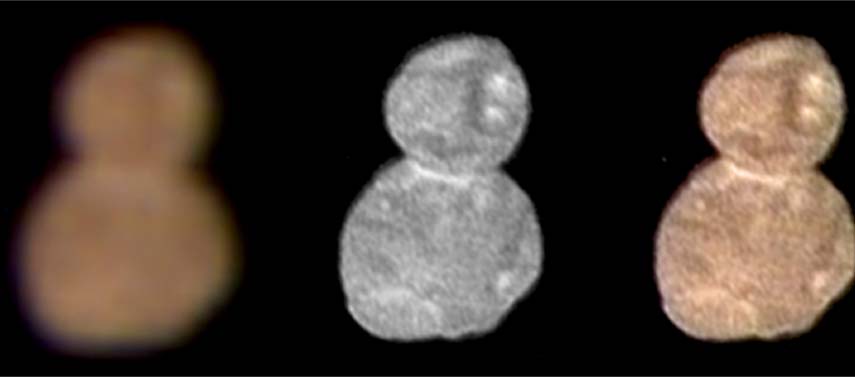NASA’s New Horizons spacecraft flew past Ultima Thule – the most distant object ever explored – in the early hours of New Year’s Day, ushering in the era of exploration from the enigmatic Kuiper Belt, a region of primordial objects that holds keys to understanding the origins of the solar system.
Now, scientists from NASA’s New Horizons mission have released the first detailed images of Ultima Thule, illuminating the processes that built the planets 4,5-billion years ago.
“This flyby is a historic achievement,” says New Horizons principal investigator Alan Stern of the Southwest Research Institute. “Never before has any spacecraft team tracked down such a small body at such high speed so far away in the abyss of space. New Horizons has set a new bar for state-of-the-art spacecraft navigation.”
The new images — taken from as close as 27 000km on approach — revealed Ultima Thule as a “contact binary,” consisting of two connected spheres.
End to end, the world measures 31km in length.
The team has dubbed the larger sphere “Ultima” (19km across) and the smaller sphere “Thule” (14km across).
The team says that the two spheres likely joined as early as 99% of the way back to the formation of the solar system, colliding no faster than two cars in a fender-bender.
“New Horizons is like a time machine, taking us back to the birth of the solar system. We are seeing a physical representation of the beginning of planetary formation, frozen in time,” says Jeff Moore, New Horizons geology and geophysics team lead. “Studying Ultima Thule is helping us understand how planets form — both those in our own solar system and those orbiting other stars in our galaxy.”
Data from the New Year’s Day flyby will continue to arrive over the next weeks and months, with much higher resolution images yet to come.
“In the coming months, New Horizons will transmit dozens of data sets to Earth, and we’ll write new chapters in the story of Ultima Thule — and the solar system,” says Helene Winters, New Horizons project manager.
Pictured: The first colour image of Ultima Thule, taken at a distance of 137 000km at 4:08 Universal Time on 1 January 2019, highlights its reddish surface. At left is an enhanced colour image taken by the Multispectral Visible Imaging Camera (MVIC), produced by combining the near infrared, red and blue channels. The centre image taken by the Long-Range Reconnaissance Imager (LORRI) has a higher spatial resolution than MVIC by approximately a factor of five. At right, the colour has been overlaid onto the LORRI image to show the color uniformity of the Ultima and Thule lobes. Note the reduced red colouring at the neck of the object.
Credit: NASA/Johns Hopkins University Applied Physics Laboratory/Southwest Research Institute

